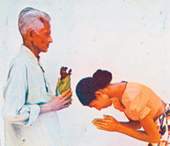| Gaveshaka
describes the many uses of betel It is the accepted practice when meeting a ‘veda mahattaya’ in the village to offer a sheaf of betel. The native physician never levies a fee or indicates how much the patient should pay him but most patients would keep a few rupees along with the betel. He would not even look at the sheaf of betel or check whether there is any money left but would just accept the betel, keep it on a side and examine the patient. Some believe that their power of healing may disappear and prefer to treat patients purely as a service without depending on any monetary benefits. These physicians and their mode of treatment come down from one generation to another and are valued dearly. Betel has close links with the temple. The devotee would take a sheaf of betel when he goes to meet the chief monk at the temple. He would first offer the betel, worship the monk and then start a conversation. When a monk is invited to deliver a sermon either in a house or at the temple, the chief householder (or the chief dayaka if it is in the temple), first offers a tray of betel as the formal invitation to start the sermon. cceptance of the betel by the monk indicates that the invitation is accepted. So it is with ‘pirit’. No words are spoken but a tray of betel is offered as the invitation to chant ‘pirit’. Tender betel leaves are hung along with other types of leaves in the ‘pirit mandapaya’ - the enclosure where monks sit and chant. At an alms-giving too, a well prepared ‘bulat vattiya’ is offered at the end for monks to chew while listening to the ‘anusasana’ (bana sermon) by one monk.
That is their first meeting. On the wedding day, betel is used for the customs at the ‘poruwa’ ceremony. Once the couple mounts the ‘poruwa’, the bridegroom would be given sheaves of betel who, along with the bride put them on the ground. Beginning with the mother of the bride, the couple would then offer betel to all the close relations of both parties as a mark of respect. Each elder would walk up and accept betel from the couple. At funerals too, the tray of betel would be kept in the open verandah for those who come to pay their respects to the dead person to have a chew. The monks who come for the ‘pansakula’ ceremony would be invited to perform the last rites by offering a tray of betel. The parents
are offered betel during Sinhalese new year by the children who
ask that they be forgiven for any wrongs done by them during the
year. The parents gladly accept the betel and reciprocate by giving
them gifts and ‘ganu denu’ in the form of some cash.
When visits
are made to homes of close relations during new year, betel is taken
and offered to the elders. On the auspicious day to apply oil on
the head, an elder uses a betel leaf to apply the oil chanting verses
blessing the person. Thus betel remains a vital element in the values
we have built and treasured over the ages. |
||||
Copyright © 2001 Wijeya Newspapers
Ltd. All rights reserved. |
 The
presentation of a sheaf of betel (bulat hurulla also referred to
as bulat atha) as a form of greeting has continued over the ages.
Traditionally, the ‘atha’ consists of forty leaves and
is considered as ideal to be used for formal occasions. School children,
mostly in rural areas, offer a ‘bulat atha’ to greet
their new teacher on the first day in school at the beginning of
the new year.
The
presentation of a sheaf of betel (bulat hurulla also referred to
as bulat atha) as a form of greeting has continued over the ages.
Traditionally, the ‘atha’ consists of forty leaves and
is considered as ideal to be used for formal occasions. School children,
mostly in rural areas, offer a ‘bulat atha’ to greet
their new teacher on the first day in school at the beginning of
the new year.